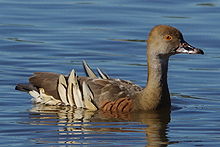- Plumed Whistling Duck
-
Plumed Whistling Duck 
At Australia Zoo Conservation status Scientific classification Kingdom: Animalia Phylum: Chordata Class: Aves Order: Anseriformes Family: Anatidae Subfamily: Dendrocygninae Genus: Dendrocygna Species: D. eytoni Binomial name Dendrocygna eytoni
Eyton, 1838The Plumed Whistling Duck (Dendrocygna eytoni), also called the Grass Whistle Duck , is a whistling duck which breeds in New Guinea and Australia. It is a predominantly brown-coloured duck with a long neck and characteristic plumes arising from its flanks. The sexes are similar in appearance.
Contents
Taxonomy
Described by English naturalist Thomas Campbell Eyton in 1838, its specific epithet honours its namer. Its generic name is derived from the Ancient Greek terms dendron "tree", and kuknos (via Latin cygnus) "swan".[1] Alternate common names include; Eyton's Plumed, Red-legged or Whistling Tree-duck, and Grey or Red-legged Whistler
Description
Measuring 42–60 cm (16.5–24 in) and weighing around a kilogram, it is a long-necked duck with brown upperparts, paler underparts and a white rump. The chest is chestnut with thin black bars, while long black-margined plumes arise from its flanks. Its bill and legs are pink, and its iris is yellow. The male and female are similar in appearance.[2] The species has a characteristic lowered neck and short, dark, rounded wings while flying.[3]
The call is a characteristic whistle which gives the bird its common name.[3]
Distribution and habitat
The range is eastern, northern and central Australia from the Kimberley across the Top End and Cape York, down to southern Queensland and northern New South Wales on the east coast, although may reach northwestern Victoria inland, in the vicinity of the Murray River.[4] It is also found in New Guinea. The preferred habitat is tall grassland and savanna, often near bodies of water.
Feeding
Rather than diving for food in bodies of water like other ducks, the Plumed Whistling Duck feeds by cropping grass on land.[5]
Breeding
The Plumed Whistling Duck breeds during the wet season, generally in January to March, although it can be later in April or, in a few cases, May. One brood is raised per season. The nest is a mattress of grasses or similar material in tall grass, or in or near vegetation as cover. 10 to 12 oval eggs are laid, measuring 48 x 36 mm; 14 or more have been recorded on occasion. Initially shiny and creamy-coloured, they may become stained.[4] The incubation period is around 30 days.
Gatton, SE Queensland, Australia
References
- ^ Liddell, Henry George and Robert Scott (1980). A Greek-English Lexicon (Abridged Edition). United Kingdom: Oxford University Press. ISBN 0-19-910207-4.
- ^ Simpson K, Day N, Trusler P (1993). Field Guide to the Birds of Australia. Ringwood, Victoria: Viking O'Neil. p. 174. ISBN 0-670-90478-3.
- ^ a b Slater, Peter (1970). A Field Guide to Australian Birds:Non-passerines. Adelaide: Rigby. p. 227. ISBN 0-85179-102-6.
- ^ a b Beruldsen, G (2003). Australian Birds: Their Nests and Eggs. Kenmore Hills, Qld: self. p. 161. ISBN 0-646-42798-9.
- ^ Wade P. (ed.) (1977). Every Australian Bird Illustrated. Rigby. p. 55. ISBN 0727000098.
- BirdLife International (2004). Dendrocygna eytoni. 2006. IUCN Red List of Threatened Species. IUCN 2006. www.iucnredlist.org. Retrieved on 11 May 2006. Database entry includes justification for why this species is of least concern
External links
Categories:- IUCN Red List least concern species
- Dendrocygninae
- Birds of South Australia
- Birds of Western Australia
- Birds of Papua New Guinea
- Birds of Western New Guinea
Wikimedia Foundation. 2010.





